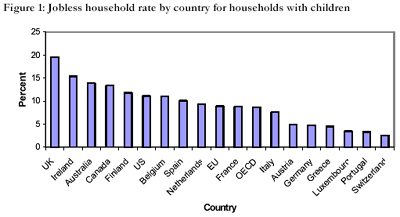International comparison of trends in the polarisation of employment
Dawkins, Gregg and Scutella (2001) using the Income and Housing Costs Survey show that the incidence of jobless families rose between in Australia between 1982 and 1997 despite rising employment. This paper suggests that while part of the increase in the jobless household rate has been due to demographic change, part of it has also been due to changes within the labour market that have led to jobless family rates within household types to also rise.
This trend in Australia for employment to become more polarised is one common throughout most of the OECD. However, as is shown in Figure 1, Australian families with children fare quite badly relative to their OECD counterparts, apart from the UK and Ireland. Our objective is thus to further our initial research and compare the Australian experience to that of other leading industrialised nations. The countries to be examined in the analysis alongside Australia are: New Zealand, the U.S., Spain, Germany, Canada and the United Kingdom.

This research is important to policy makers, as its objective is to highlight not only the differences in the levels and changes in polarisation across industrialised nations, but also in the differences in what is driving the polarisation. Once we know what the drivers of the increase in polarisation are for each nation, we will be in a better position to speculate as to what is particular about the Australian environment that may be driving this inequality in the labour market. And in particular, what disadvantages do families with children face that are specific to Australia. For instance, are families with children in Australia faced with disincentives associated with the social security system that are not apparent in other industrialised nations?
More information about International comparison of trends in the polarisation of employment ) (pdf 192kb)
Project is complete.
